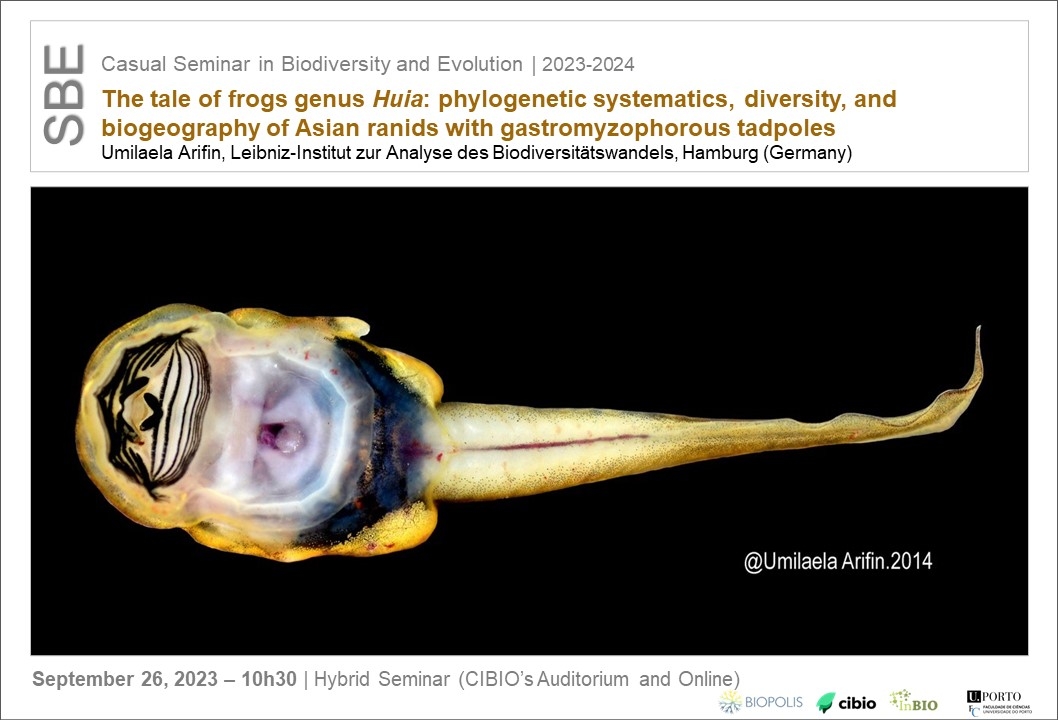The tale of frogs genus Huia: phylogenetic systematics, diversity, and biogeography of Asian ranids with gastromyzophorous tadpoles
Event
CASUAL SEMINAR IN BIODIVERSITY AND EVOLUTION
September 26th, 2023
Umilaela Arifin, Leibniz-Institut zur Analyse des Biodiversitätswandels, Hamburg (Germany) | 10h30 | Hybrid Seminar

CASUAL SEMINAR IN BIODIVERSITY AND EVOLUTION
The systematics and phylogenetic relationships of Asian ranid frogs of the genus Huia has been unstable for decades and has not been convincingly resolved. Prior to my study, five species (H. cavitympanum, H. masonii, H. sumatrana, Huia modigliani, and H. melasma) were recognized under the genus Huia. However, none of available studies suggested that Huia is a monophyletic group and provided adequate systematics solutions, leaving the genus to languish in classification that is evolutionary incoherent. In my study, I generated the most comprehensive taxon sampling of Huia via extensive fieldwork and museum loan. Under the framework of integrative taxonomy, my analysis (of molecular and morphological data of adults and larvae) revealed that Huia is a paraphyletic group, which corroborates the previous hypothesis. The type species H. cavitympanum was recovered as the sister lineage to the genus Meristogenys, while the remaining members of Huia formed a monophyletic group that was sister to the Bornean clade (H. cavitympanum+Meristogenys). Although my study did not change the phylogeny of Huia frogs, my analyses: (i) disclose multiple highly divergent, undescribed lineages of ranids with gastromyzophorous tadpoles in Sumatra and Java; (ii) confirm the tadpole of Huia melasma; (iii) provide evidence to justify the retention of the genus Huia and to erect a new genus to accommodate the remaining members. In general, my study highlights the importance of expanded geographic sampling and the utility of tadpole morphology to diagnose lineages that are otherwise hard to differentiate as adults.
Dr. Umilaela Arifin, originally from Indonesia, discovered her passion for tropical biodiversity after joining a three-months herpetological expedition on Sulawesi island with an international team in 2004. She then convinced herself to become a herpetologist. After completing her B.Sc. (2006) and M.Sc. (2008) at the Bandung Institute of Technology, Indonesia and working as a freelance researcher, she got a scholarship to pursue her doctorate at University of Hamburg, Germany in 2013. She is currently a Marie Curie Researcher at the Leibniz Institute for the Analysis of Biodiversity Change, Germany and the University of California Berkeley, USA. Her current research focused on understanding the eco-morphological evolution of Asian ranid frogs with belly sucker tadpoles. Apart from her research activities, she is actively engaged in various outreach activities and promoting intercultural diversity wherever she is, e.g., in Germany, USA, and Indonesia. She believes that knowledge transfer is equally important as doing research. Her research and career have been featured in numerous media arrays in English, German, and Indonesian languages, including Forbes, Discovery Channel Canada, and 1mwis. Furthermore, she is one of the organisers of the Women in Herpetology Project, which aims to put a spotlight on the diversity of women herpetologists across disciplines, regions, and cultural backgrounds.
[Host: Angelica Crottini, Biogeography and Evolution - BIOEVOL]
Click here to watch the seminar recording
Click here to watch the seminar recording
